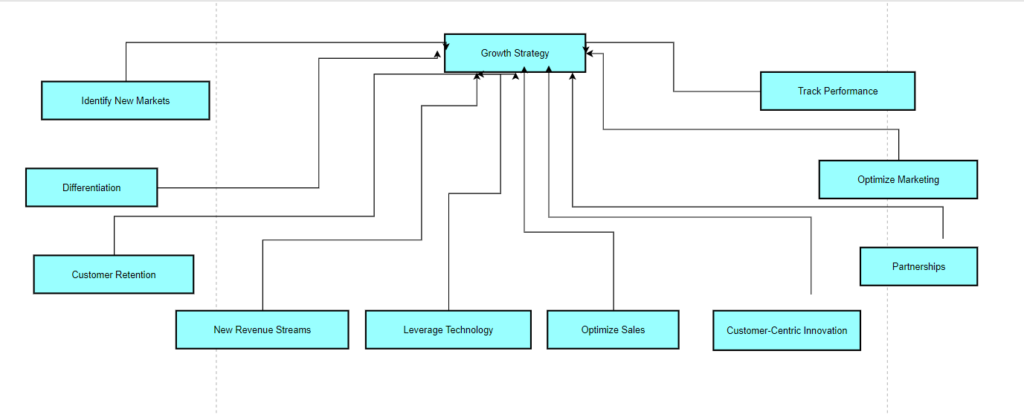Introduction

In today’s highly competitive market, companies need to implement strong growth strategies to keep moving forward and stay ahead of their competitors. A carefully crafted growth plan not only boosts revenue but also ensures long-term success. Whether your goal is to broaden your market presence, diversify your products, or enhance profitability, choosing the right strategies is essential.
1. Identify Target Markets for Expansion
Expanding into new markets is often a key part of any growth plan. To effectively find new markets:
– Examine customer demographics to gain insights into buying habits and preferences.
– Investigate unexplored areas or segments where there is a rising demand for your product or service.
– Use existing customer data to forecast which markets might be a good fit for your offerings.
By understanding the diverse needs of various demographics, we can customize our strategies to target the most lucrative market segments.
2. Strengthen Product/Service Differentiation
Making your product or service stand out from the competition is crucial for driving growth. This includes:
– Enhancing unique selling points (USPs) that address specific customer challenges.
– Integrating customer feedback into product development to ensure it meets market demands.
– Prioritizing quality improvements that enhance the overall customer experience.
When customers recognize our offerings as unique and superior, their loyalty and sales tend to rise.
3. Invest in Customer Retention
While bringing in new customers is important, keeping existing ones is often more cost-effective and can greatly contribute to growth. To boost customer retention:
– Implement loyalty programs that reward repeat purchases.
– Provide outstanding customer service to ensure satisfaction at every interaction.
– Use personalized marketing strategies that address individual customer needs and preferences.
By concentrating on retention, businesses can enhance customer lifetime value and cultivate stronger relationships with their clientele.
4. Explore New Revenue Streams

Finding different ways to earn can boost growth and shield against market ups and downs. Here are some ideas to generate new income:
– Launch additional products or services that meet customer demands.
– Create subscription plans for steady income.
– Share your knowledge through consulting, online courses, or digital goods.
By broadening income sources, businesses can stabilize their earnings and explore new profit opportunities.
5. Leverage Technology for Scalability
Technology is essential for efficiently expanding operations. To harness tech for growth:
– Automate tasks like customer service, marketing, and managing inventory.
– Use cloud services to enhance teamwork and cut down on costs.
– Analyze data to make smart business choices, from managing stock to understanding customers.
With the right technology, businesses can grow while using fewer resources.
6. Optimize Sales Processes
Making the sales process more efficient is key to maintaining growth. Here are some ways to enhance sales:
– Use a CRM system to track leads, manage customer relationships, and predict revenue.
– Train the sales team to align with company objectives and provide tailored pitches.
– Shorten the sales cycle by spotting inefficiencies and removing obstacles to buying.
A streamlined sales process boosts conversion rates and ensures that potential revenue is captured effectively.
7. Focus on Customer-Centric Innovation
Innovation that focuses on what customers want is crucial for long-term success. Businesses can encourage customer-focused innovation by:
– Regularly conducting market research to keep up with customer preferences and industry changes.
– Collaborating with customers through feedback and surveys to improve products.
– Trying out new features that solve customer problems directly.
The more we innovate based on what customers need, the better our chances for sustainable growth.
8. Expand Partnerships and Collaborations
Creating strategic partnerships can greatly enhance business growth by opening doors to new markets and utilizing shared resources. To form effective collaborations:
Find partners that align with your business model and share similar values.
Look into joint ventures, cross-promotions, or co-branded projects to reach each other’s customer bases.
Negotiate agreements that are beneficial for both sides, promoting long-term cooperation.
Collaborative growth enables businesses to expand their market presence without taking on all the financial or operational responsibilities alone.
9. Optimize Marketing Efforts
An effective marketing strategy is essential for business growth as it increases visibility and attracts customers. Important steps to enhance marketing include:
Investing in content marketing like blogs, videos, and social media to connect with potential customers.
Launching targeted digital advertising campaigns aimed at high-intent customers.
Implementing SEO techniques to ensure your website ranks well for relevant keywords, increasing organic traffic.
By blending paid, organic, and content-focused marketing strategies, businesses can broaden their reach and turn prospects into loyal customers.
10. Track Performance and Adapt
Growth strategies need to be continuously improved based on performance metrics. To keep strategies effective:
Establish measurable KPIs to track performance in various business areas.
Conduct regular reviews to evaluate what’s successful and what requires changes.
Remain flexible and ready to adjust strategies in response to market shifts or new opportunities.
By carefully tracking performance and modifying approaches, businesses can keep their growth strategies relevant and effective.

Conclusion
Growing a business requires a diverse strategy that includes expanding into new markets, keeping customers happy, embracing technology, and fostering innovation. By applying the strategies mentioned above, businesses can speed up their growth and build long-term success in their field. Prioritizing customer needs, streamlining processes, and adapting continuously are essential elements that drive strong, scalable success.


